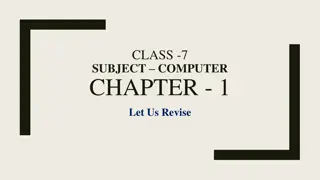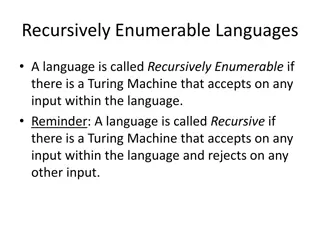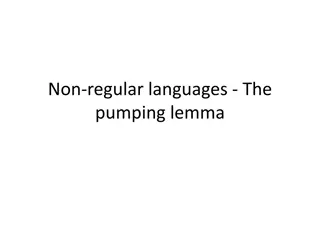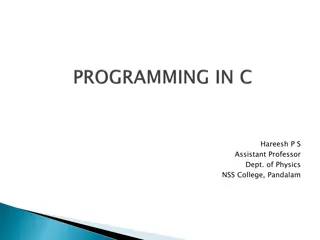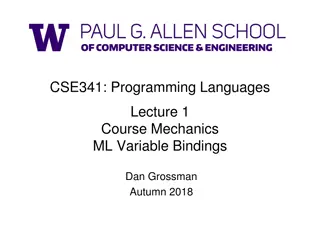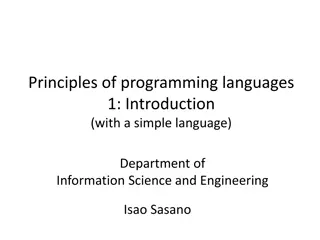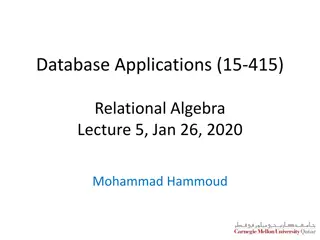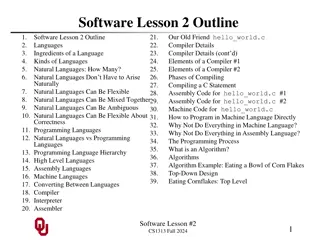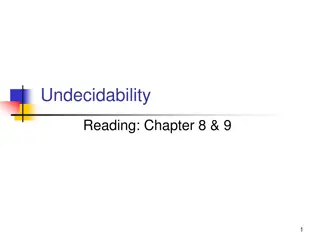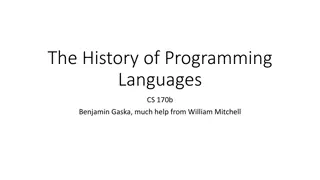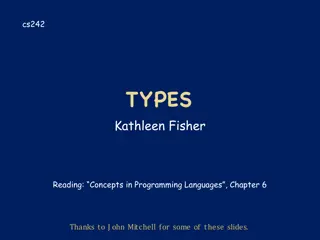Essential Principles of Teaching Programming Languages
Foundational concepts in programming form the core of computing. This encompasses understanding programming fundamentals, teaching language aspects effectively, statistical programming for data analysis, and guiding students unfamiliar with programming environments towards grasping the logic and simplicity of languages.
Download Presentation

Please find below an Image/Link to download the presentation.
The content on the website is provided AS IS for your information and personal use only. It may not be sold, licensed, or shared on other websites without obtaining consent from the author.If you encounter any issues during the download, it is possible that the publisher has removed the file from their server.
You are allowed to download the files provided on this website for personal or commercial use, subject to the condition that they are used lawfully. All files are the property of their respective owners.
The content on the website is provided AS IS for your information and personal use only. It may not be sold, licensed, or shared on other websites without obtaining consent from the author.
E N D
Presentation Transcript
Programming Fundamentals
Programming concepts and understanding of the essentials of programming languages form the basis of computing.
Goals To outline what aspects of a language (specifically R) you might want to teach your students Discuss how to teach this effectively concepts, examples, motivation, context Discuss aspects of the language that not all users are familiar with and to show the logic/simplicity of the language
Three aspects to statistical programming interactive use for exploratory data analysis programming numerically intensive tasks writing functions/software for reuse Obviously related, and there is a natural progression.
Some students wont have seen a programming language before Some may have seen HTML - a declarative language that has no control flow. Many will be unfamiliar with the command-line REPL - Read-Eval-Print-Loop Explain the difference between a spreadsheet and a programming environment.
For some students, we have to get them past the why isnt this like X? It s so lame! So need to show them how it is useful, and how the language constructs help them to do things. So we have to get them to want to do something which involves, e.g. a lot of repetition. e.g. give them a corpus of e-mail messages, 1 per file, or person per file and ask how many messages do we have? Get them to consider the language as a servant.
What is a computation? Transformation from on or more inputs to an output Transition from old state to new state Algorithm set of directions for carrying out a computation in terms of other simpler computations Examples Find the average annual rainfall at a weather station Crop a digital photo Sort the mail by sender in your mail program
Language Model Critical to teach the concepts, structure, logic and design of the language Students will often gravitate to how to and mimicking rather than abstracting the specific to gain this higher understanding of the language. Syntax versus Semantics and computational model. Getting past details allows them to reason about problems apply their knowledge of one language to another.
Most of the languages we will use are interpreted high-level garbage collected interactive & have large libraries R, MATLAB, ... - triple of language interpreter environment (packages)
Getting Started Get students familiar with the basics of the environment. Do this with an interactive demo. Place online after class a transcript of session (with comments). How to start (command line or GUI) and quit q() How to use R as a calculator Show them the continuation prompt > 2 * + 3
Terminology Invoke a computation with an expression Pass the expression off to the computer to evaluate Return a value or output of the expression
Syntax Do arithmetic - 1 + pi Order of operations log(100) + sin(pi/2) * 15 (log(100) + sin(pi/2)) * 15 Simple plots - curve(sin, -pi, pi) Assign results to variables x = 1 + pi print(x) x result of evaluating a non-assignment => print
Transcript > 1 + pi [1] 4.141593 > log(100) + sin(pi/2) * 15 #multiplication first, log base e [1] 19.60517 > (log(100) + sin(pi/2)) * 15 #parentheses modify order [1] 84.07755 > (log(100, base = 10) + sin(pi/2)) * 15 #change parameter called base [1] 45
Transcript > curve(sin, -pi, pi) #curve function called, 3 arguments > x = 1 + pi > print(x) [1] 4.141593 > x [1] 4.141593 > x = rnorm(100) > mean(x) [1] 0.02533064
Parsing: break down expression white space, digits 2x vs 2*x, naming conventions No declarations of variables needed or type information
Explore assignments stored in session area - global environment see names of existing variables - objects() where does curve() come from? find( curve ) search() and the concept of the search path how does R use this > pi= 3 > find("pi") [1] ".GlobalEnv" "package:base"
Remove one or more objects rm(x, pi) Save variables for future use = myvars.rda ) save(x, z, file Restore load( myfile.rda ) (Where are these?) Keep track of code history()
What about + in 1 + 2? Does R just know about that? find( + ) package:base 1 + 2 is actually a function call `+`(1, 2) In fact, everything in R is a function call simple, single concept that makes lots of things easy to reason about, and several computational tasks feasible. (infix vs function style) Notion of function call is similar to other languages e.g. shell - find . -name '*.R'
Everything's an Object If we can see 'x', can we see '+'? Print the value of + - poor choice! `+` sin We can pass a function as an argument to a function curve(sin) So functions are first class values. In fact, every value is a first class object.
Function Calls What's a function? for now, a black box that takes zero or more inputs, and returns a value, an object. leads to 2 issues: how do we specify the inputs parameter matching what sort of values can we pass in and get out? data structures
Getting Help How to get help (help.start) It is useful to show them the elements of a help page and how to read them, interpret some of the "ambiguous" content, explain some of the terms follow the See Also connect to the manuals which give some more details
Help Page help(mean) Description - what the function does Usage definition/how to call the function Arguments - purpose of each argument Value return value from function References - See Also related functions Examples -
Work environment Where do you write your code? Not in a Word document Text editors the GUI s editor, eMacs & ESS How do you find your data, code? File system trees Simple shell commands cd, ls, pwd, cp, mv, rm, mkdir, rmdir Can you use a faster computer? ssh, scp






